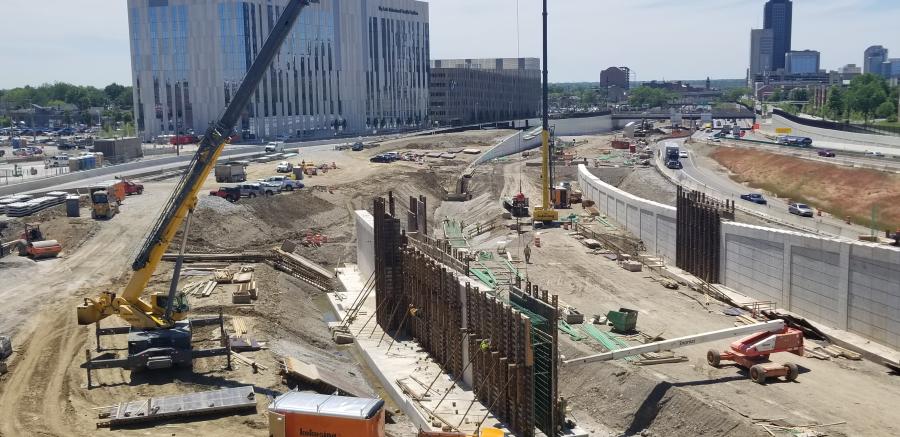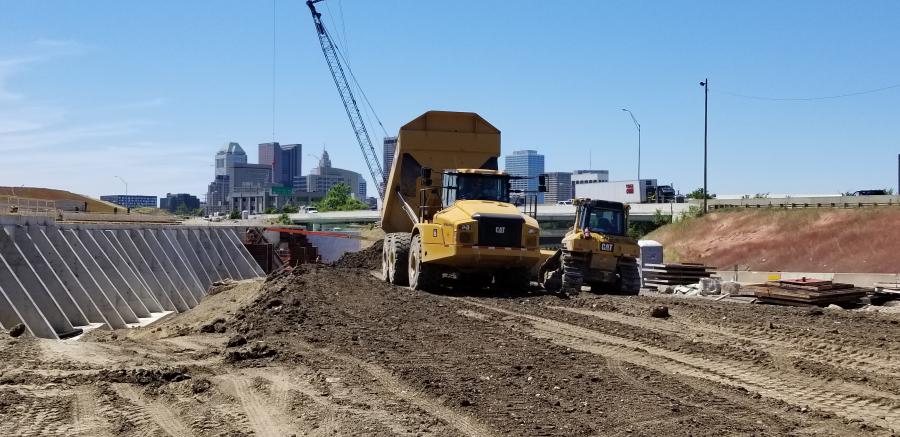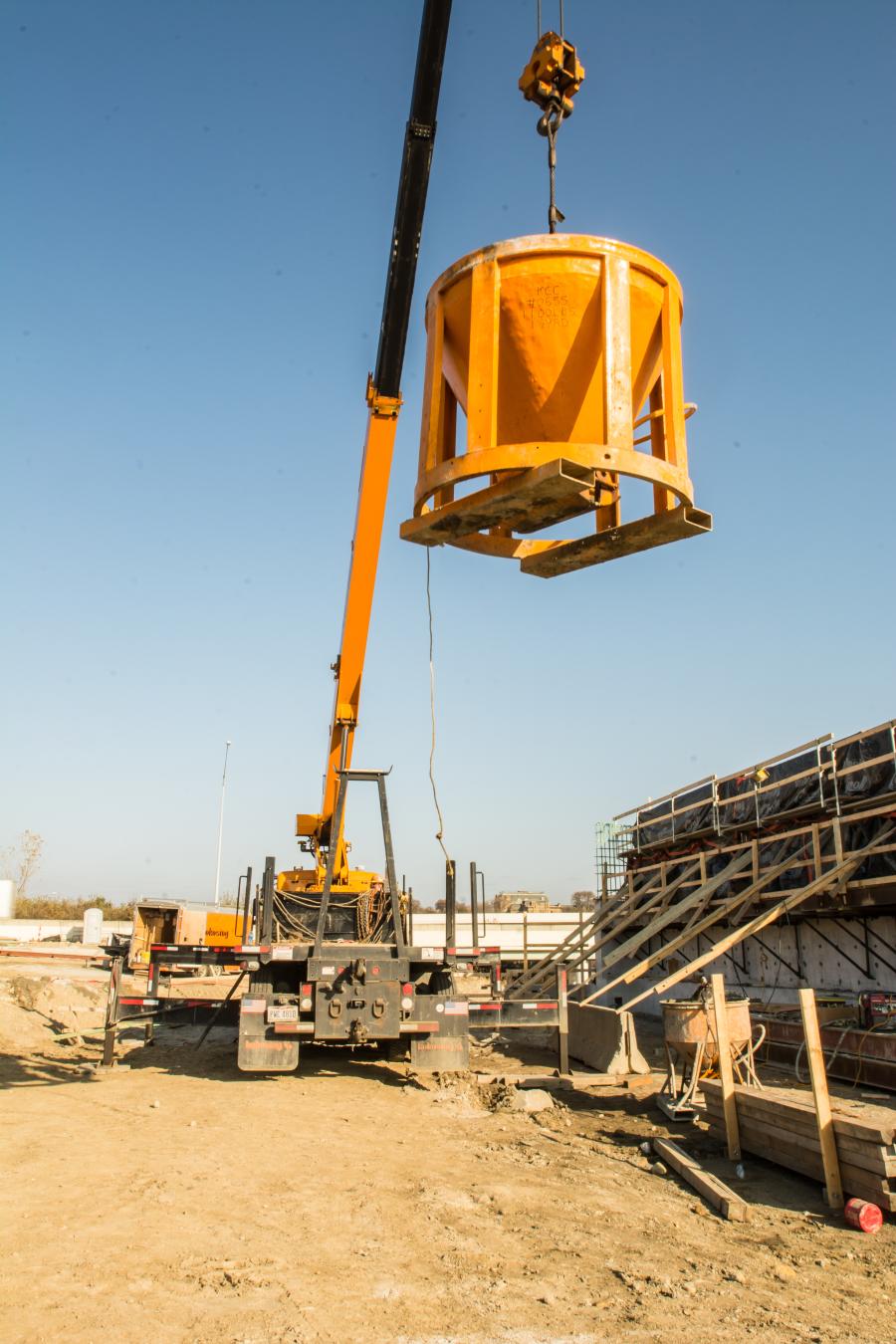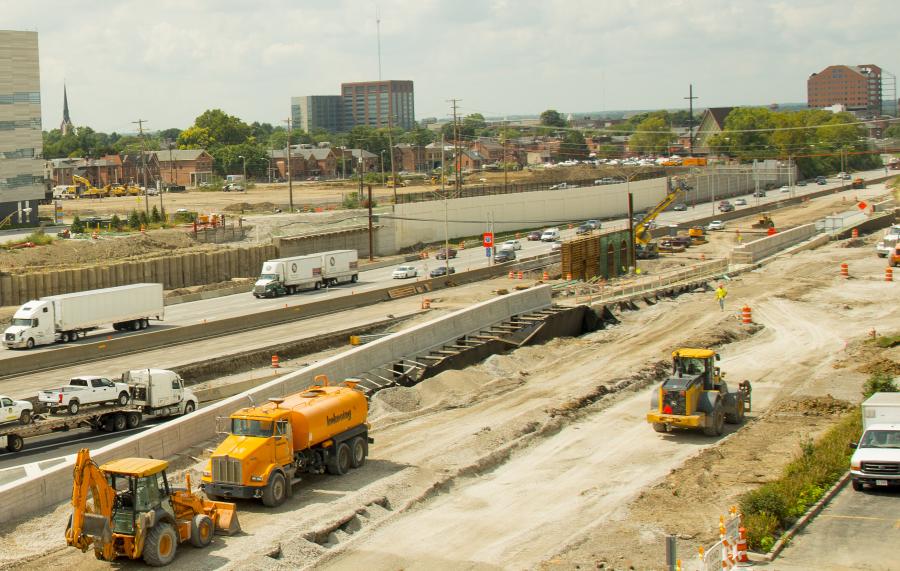“Although the site is within a closed traffic zone, the room is so narrow that we regularly work at night to close adjacent lanes to provide us with space for our equipment,” said Steve Marincic, Kokosing’s Columbus area manager.
(Kokosing Construction Company Inc. photo)
The Ohio Department of Transportation's (ODOT) $1.3 billion I-70/I-71 Downtown Ramp Up project in the city of Columbus (Franklin County) is helping to replace, upgrade and rehabilitate aging highway infrastructure in the downtown core and improve traffic flow and safety for motorists.
The initiative — financed with federal, state and local funds, which began in 2011 — is expected to be completed in 2037 or sooner. Kokosing Construction Company Inc. currently is engaged in work for Phases 2E ($81 million) and 3B (Broad Street, $41 million), and has completed Phase 1 (2011-14, more than $200 million) and 2G (2017-2019, $44 million).
"The Downtown Ramp Up is a series of projects to reconstruct Interstates 70/71 in downtown Columbus and alleviate the biggest safety and congestion problems along the corridor," said Breanna Badanes, ODOT's public information officer of central Ohio. "We have already invested $270 million into the interchange improvements, and another four projects worth more than $300 million will be constructed in the next five years to rehabilitate the road network.
"These projects were undertaken due to high crash rates and heavy congestion into and out of downtown Columbus," she added. "When complete, they will result in new urban avenues with complete streets, enhanced freeway crossings with safe pedestrian and bicyclist accommodations and the removal of unsafe ramps."
The work is widening I-70/71 between SR 315 and I-71 to provide two through lanes for each route in each direction; constructing an additional lane on I-71 south at Broad Street; replacing numerous bridges, including Broad Street, Front Street, bridges over the Scioto River, and bridges over the railroad tracks; reconfiguring ramps to and from the downtown area; and building Lester Drive and Elijah Pierce Avenue between Spring Street and Broad Street.
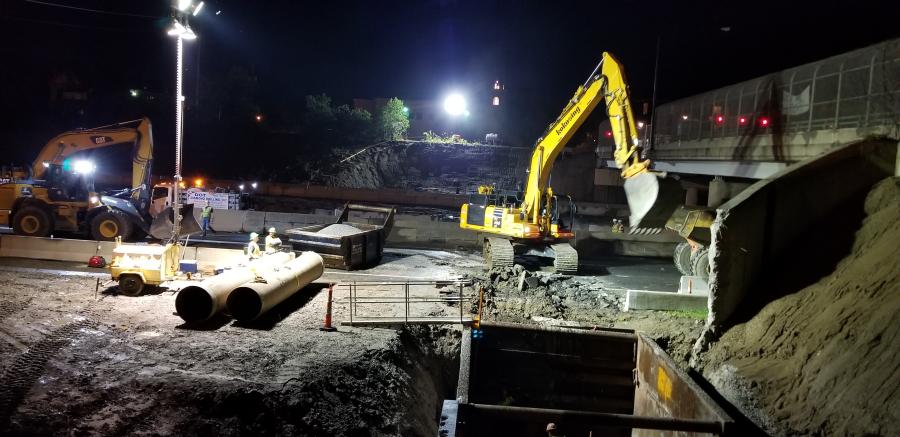
Mooberry Street and Parsons Avenue are being reconstructed, which is impacting several ramps. The I-70 east to 18th Street ramp is being replaced by a new ramp from I-70 east to Parsons Avenue; the Third Street ramp to I-70 east is being replaced with a ramp from Fulton Street to I-70 east; the I-70 east ramp to Front Street is being replaced with a ramp from I-70 east to Fulton Street; and the ramps from I-71 south to Broad Street and Broad Street to I-71 north closed permanently and will be replaced with new connections via Lester Drive and Elijah Pierce Avenue. The ramp from I-70 east to SR 315 north, following the work, will be closed permanently.
"ODOT has been planning this project since the early 2000s," said Badanes. "This corridor is only 6 percent of Columbus freeway miles but represents 27 percent of freeway crashes, so safety was the primary driver."
MS Consultants designed the roads and bridges for Phase 2E and Burgess and Niple designed road and bridges for Phase 3B.
"The biggest challenge for both design and construction is the scale of the project and the limited amount of space to work in," said Badanes. "To overcome that, the design includes several retaining walls so we could widen the freeway, but still maintain the same footprint. The existing infrastructure from the 1960s has reached the end of its life. Today's population in the metro area has more than doubled, so it's important to deliver a modern, upgraded transportation system that meets the needs of our growing city for years to come."
One unique aspect of this project is the concept of building "urban avenues" to collect and distribute freeway traffic, sorting traffic while traveling at lower speeds rather than interstate speeds. Another [noteworthy] component is the construction of "cap-capable" bridges over the interstate, which create the look and feel of a city street and block out the freeway backdrop.
"Constructing bridges that can offer greenspace or support buildings helps to enhance pedestrian crossings and reconnect the neighborhoods that were separated by the initial construction of the highway," said Badanes.
The construction has impacted traffic via permanent and temporary ramp closures and detours. ODOT has created alternative routes to enter and exit the downtown core and provides construction and traffic updates via several social media sites.
"To help crews safely access the job site, ODOT requires a ‘deceleration lane' near the construction entrances to give workers adequate space to slow down or speed up when coming to or from the work zone," said Badanes. "Because it's such a tight space, it's that much more important for drivers to slow down and stay alert."
Shifting I-70 eastbound traffic to the north and closing the exit ramp to 18th Street allowed crews to rebuild I-70 east over Parsons Avenue.
The overall project has been divided into six larger phases with several smaller projects: Phase 1 — I-71/I-670 Interchange; Phase 2 — East Interchange, that deals with 2B (storm sewer), 2C (Mound Street connector ), 2D (an interchange), 2G (Grant Avenue bridge) and the current 2E; Phase 3 — East Innerbelt, that includes the current 3B (Broad Street); Phase 4 — South Innerbelt, divided into 4A (I-70 eastbound), 4B (South Innerbelt) and 4R (inbound downtown ramps); Phase 5 — East Freeway; and Phase 6 — West interchange that is split into 6A (I-70 Westbound), 6B, 6C, 6D and 6R (outbound downtown ramps).
General contractors are currently engaged in Phases 2E and 3B, and have completed phases 1, 2B, 2C and 2E.
"We began 3B in April and are currently working on a major sanitary siphon relocation that, once relocated, will let us get to the major bridge and retaining wall work on the job," said Steve Marincic, Kokosing's Columbus area manager. "We also have completed a portion of the Broad Street I-71 NB ramp and bridge demolition."
The main elements of 3B, to be completed in June 2022, are the new widened Broad Street bridge, along with all of the architectural additions (lighted screen walls, street and walk path lighting and planter boxes), I-71 retaining walls on the NB and SB sides, added lanes on the NB and SB I-71, and the sanitary syphon relocation.
Phase 2E began in April 2019 and should be delivered in November 2021.
"We spent all of 2019 on roadway work creating new ramps along the perimeter of the project which moved all of the existing traffic to the outskirts of the I-70/I-71 interchange," said Marincic. "This involved six traffic phases and gave us access to the meat of the project in the middle. As of this past winter, we're building three eastbound bridges, one I-70 flyover bridge and six major retaining walls."
Portions 2E and 3B are approximately 0.5 mi. apart from each other and share similar challenges, such as limited work space.
"We have to maintain traffic through both of the projects while they are being built and they are located in a very narrow urban right-of-way," said Marincic. "Although the site is within a closed traffic zone, the room is so narrow that we regularly work at night to close adjacent lanes to provide us with space for our equipment. Material storage is a major factor and the amount of planning required to make it all work is extraordinary. We have all of our different trades working in the same area and it takes a lot of collaboration and coordination, sometimes on an hourly basis, to make it all work."
Portion 2E contains the ramps from the highway to the Nationwide Children's Hospital. The project will greatly improve access to the hospital. Via sequencing, access to the hospital changes frequently.
"This requires a great deal of coordination with Nationwide Children's Hospital, which is an extremely good partnership," said Marincic. "It has been a pleasure working with them."
Excavation crews are encountering very dense silt, which has posed a problem for shoring to get sheeting down the toe.
"Then there are pockets of sand and gravel where we have water to manage," said Marincic. "The silt is difficult to work with. We need to use it for embankment, but it has a very narrow window of optimum moisture. There also is a lot of previously disturbed soil that causes some challenges for the excavation during underground utility installation."
Some elements have crews working 24/7, and some operations were conducted throughout the winter.
"We structured our CPM so that we could do a lot of our structure foundation work throughout the winter months," said Marincic, who noted that overseeing multiple work sites helps to manage manpower and equipment resources for both phases. "This maximizes efficiency and production. We are able to easily move crews and equipment back and forth as needed to maintain our schedules, but every once in a while you run into conflicts and have to do your best to prioritize. Our relationship with ODOT and the city are longstanding and continue to be positive productive partnerships. Our company has been family owned and operated for more than 69 years and Columbus is essentially our home town."
Road construction is progressing, and with no rock in the area, excavation presses forward. However, a major issue involves the logistics of removing excavated materials and bringing in new materials.
"There are many instances where the trucking is one-way in and one-way out," said Marincic. "It's a challenge to optimize your production with the limited working room. In many instances we utilize night shifts, which helps us move material more efficiently. Having multiple projects so close together helps as we can leverage the borrow and waste needs between them."
Kokosing has excavation, road and bridge crews operating simultaneously and having several asphalt plants in Ohio, including one in Columbus, coordinates operations and maximizes shifts.
The bridge work is meeting benchmarks.
"The aesthetics for the bridges are the same throughout the entire Columbus area and that allows you to share form work between projects," said Marincic. "Undoubtedly the biggest challenge regarding the bridge and wall work is the limited amount of work space. The storage of rebar, forms, and the room for your cranes poses great challenges for making excavations and placing backfill. For these bridges, you start at the bottom with the substructure and work up to the superstructure."
The substructures are concrete and most of the superstructures use prestressed concrete beams, while two longer span bridges are steel girder bridges.
"These are unique in that they will not have traffic running directly on the decks — they have embankment built on top of them, which makes them more like tunnels," said Marincic. "We've sequenced our substructure and superstructure work for those two bridges to be constructed concurrently and have one set of crews dedicated to those tunnel bridges. Another set of crews are working on the standard type bridges."
Completion time for a typical bridge is between six months and one year.
The underground infrastructure is being installed as the roads are being built, but this work is affected by the high presence of existing underground utilities in the urban setting. These existing utilities are often mis-marked on maps and sometimes not recorded at all.
"In many cases the utility owners — telephone, electric, internet and cable — don't have precise locations for their underground facilities and there are a lot of them in the ground here," said Marincic. "Through Ohio's One-Call system we get a general idea of the utility locations and we use our truck mounted Hi-Vac Aquatech combination jet vac system often to expose the utilities using non-destructive methods to install the new storm and sanitary sewers and water lines. This helps us to work safely and avoid service interruptions. Learning the hard way has taught us that it's much better to fully expose all the existing utilities before sticking a bucket into the ground."
At times, the locations of the existing underground utilities conflict with the plan design location of new underground utilities. This issue has caused some delays. To ensure that new sewer and water lines can be installed and work as designed, "we partner with ODOT to come up with engineering solutions," said Marincic. "That involves design changes and sometimes schedule impacts, and we work together to mitigate the delays and solve problems."
The use of Hi-Vac Aquatech combination jet vac system is crucial, as well as Kokosing's fleet of articulated-end dump trucks for excavation work.
"For more typical operations we tend to use the 45-ton Cat 745s," said Marincic, "but in the downtown area we can be more productive with the smaller 30-ton Cat 730 articulated trucks that help us get in and out of tight quarters a lot easier. We have found slight production increases in using the smaller units that cost us a little bit less to run."
Marincic credits his entire team with the project's success.
"It's a big team and we work as a team," said Marincic. "I couldn't be prouder of them and the crews that we have. The amount of cooperation, collaboration and professional expertise is head and shoulder above what I consider average."
On Phase 2e, Marincic credited:
- Scott Beveridge,
- Jeff Geisbuhler,
- Scott Overmier,
- Cory Brubaker,
- Jeremy Overholt,
- Gary Hall,
- Matt Craig,
- Jacob Calendine, and
- Billy Porterfield
On Phase 3B, he thanked:
- Kevin VanDyke,
- Kyle Stalder,
- Nick Enich,
- Matt Craig,
- Jacob Calendine, and
- Billy Porterfield
Peak days have 140 plus Kokosing and subcontractor employees on site. The major subcontractors for 2E are Miller Cable Company for electrical and J&B Steel for rebar, and for 3B — Complete General Construction for electrical and Armstrong Steel Erectors for rebar.
Materials removed from demolition and excavation should total 56,500 cu. yds. of broken concrete and 400,000 cu. yds. of dirt. Some of the other major items being brought in are 45,000 cu. yds. of structural concrete; 170,000 tons of asphalt; 45,000 sq. yds. of concrete pavement; 3.9 million lbs. of structural steel; 145 prestressed concrete beams; 5.3 million lbs. of rebar; and more than 45,000 ft. of underground pipe.
"ODOT specifications do not really give us much allowance to use recycled materials within the projects," said Marincic, "but concrete and asphalt removals do get recycled at local facilities, as does the steel."
Kokosing is using: Cat and Komatsu excavators; Cat dozers; John Deere loaders; Cat articulated trucks; Manitowoc crawler cranes; Grove rough-terrain hydraulic cranes; Cat soil compactors; Cat rubber-tire backhoes; Roadtec and Vogele asphalt pavers; Sakai asphalt rollers; Wirtgen asphalt milling machines; and JLG aerial lifts.
"We keep high expectations when it comes to how our equipment is treated in the field by our crews," said Marincic. "We own just about every tool and piece of equipment imaginable and everything has its special functions. Our crews are expected to use the equipment only for what it is designed for in a safe and proper manner. Equipment abuse is not tolerated. Between our high expectations and accountability regarding the use of our equipment, coupled with our award-winning equipment management group, we leverage our outstanding fleet for success.
"We have full-time on-site mechanics," said Marincic, "and they have an infrastructure of support at our main shop — equipment managers and parts planners. We keep up on routine maintenance and when something breaks down, they fix it right. I cannot say enough about how much our equipment maintenance group helps us build projects."
Kokosing's equipment management group has won the National AEMP Fleetmasters Award.
The firm purchases equipment from Columbus Equipment, Ohio CAT, Cleveland Crane and Shovel, The McClean Company, Murphy Tractor and Skyworks LLC. CEG
Irwin Rapoport
A journalist who started his career at a weekly community newspaper, Irwin Rapoport has written about construction and architecture for more than 15 years, as well as a variety of other subjects, such as recycling, environmental issues, business supply chains, property development, pulp and paper, agriculture, solar power and energy, and education. Getting the story right and illustrating the hard work and professionalism that goes into completing road, bridge, and building projects is important to him. A key element of his construction articles is to provide readers with an opportunity to see how general contractors and departments of transportation complete their projects and address challenges so that lessons learned can be shared with a wider audience.
Rapoport has a BA in History and a Minor in Political Science from Concordia University. His hobbies include hiking, birding, cycling, reading, going to concerts and plays, hanging out with friends and family, and architecture. He is keen to one day write an MA thesis on military and economic planning by the Great Powers prior to the start of the First World War.
Read more from Irwin Rapoport here.
Today's top stories














